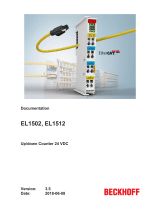
Table of contents
EK9300 3Version: 3.2.6
Table of contents
1 Foreword ....................................................................................................................................................5
1.1 Notes on the documentation..............................................................................................................5
1.2 Safety instructions .............................................................................................................................6
1.3 Documentation issue status ..............................................................................................................7
1.4 Version identification of EtherCAT devices .......................................................................................7
1.4.1 Beckhoff Identification Code (BIC)................................................................................... 12
2 Product overview.....................................................................................................................................14
2.1 EKxxxx - System overview ..............................................................................................................14
2.2 Technical data .................................................................................................................................15
2.3 Technical data PROFINET ..............................................................................................................16
3 Mounting and wiring................................................................................................................................17
3.1 Mounting..........................................................................................................................................17
3.1.1 Instructions for ESD protection ........................................................................................ 17
3.1.2 Dimensions ...................................................................................................................... 18
3.1.3 Installation on mounting rails – Bus Coupler ................................................................... 18
3.2 Wiring...............................................................................................................................................20
3.2.1 Power supply ................................................................................................................... 20
3.2.2 Ethernet ........................................................................................................................... 22
3.2.3 ATEX - Special conditions (standard temperature range) ............................................... 26
3.2.4 ATEX Documentation ...................................................................................................... 26
3.2.5 UL notice.......................................................................................................................... 27
4 Parameterization and commissioning...................................................................................................28
4.1 Meaning of the DIP switch...............................................................................................................28
4.2 Further interfaces ............................................................................................................................28
4.3 Setting the IP address .....................................................................................................................29
5 Configuration ...........................................................................................................................................30
5.1 Representation of an EtherCAT slave on PROFINET.....................................................................30
5.2 EK9300 configuration ......................................................................................................................34
5.3 EK9300 EtherCAT configuration .....................................................................................................36
5.4 EK9300 – Configuration example....................................................................................................40
5.5 From firmware Version 6 .................................................................................................................42
5.5.1 EK9300 - CoE data access over PROFINET .................................................................. 42
5.5.2 EK9300 - multi-configuration mode ................................................................................. 44
5.5.3 EK9300 - IO-LINK............................................................................................................ 46
5.6 From firmware version 8..................................................................................................................49
5.6.1 EBus Error Behaviour ...................................................................................................... 49
5.6.2 Activating the web page................................................................................................... 51
6 Ethernet ....................................................................................................................................................52
6.1 PROFINET system presentation .....................................................................................................52
7 Error handling and diagnosis.................................................................................................................54
7.1 Diagnostic LEDs ..............................................................................................................................54
8 Appendix ..................................................................................................................................................56



























